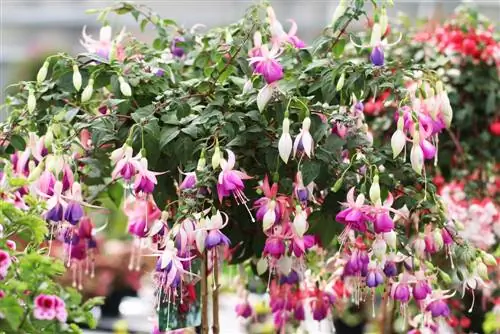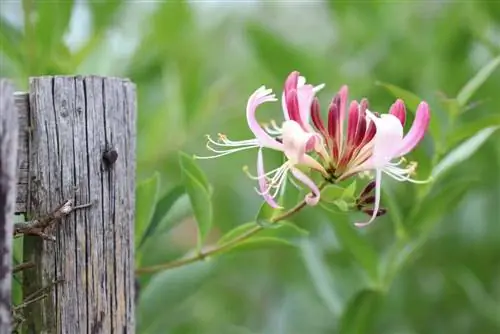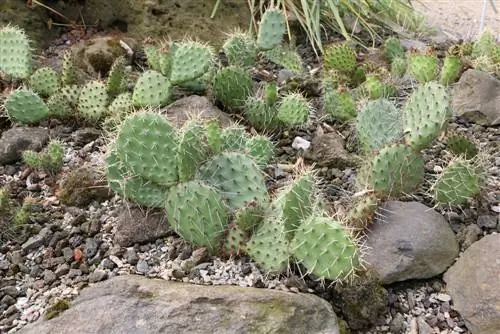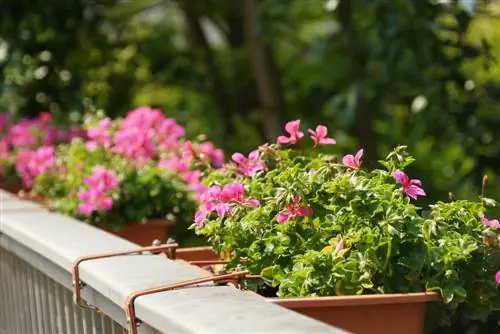- Author admin [email protected].
- Public 2023-12-17 03:39.
- Last modified 2025-01-24 12:45.
Many hobby gardeners are of the opinion that exotic plants - especially cacti - belong in the house or at least in the greenhouse during the cold season. However, if the most important requirements are met, some types of cacti also thrive in the home garden on the terrace or in the bed. Numerous species are native to the desert, where they can withstand the hot temperatures during the day and survive sub-zero temperatures at night unscathed. Species of the genus Echinocerus, Opuntia and Escobaria also thrive and bloom in our latitudes and become a real eye-catcher in the snow-covered garden.
Special features
So that the prickly creatures survive the cold season, they use a fascinating process. They are able to evaporate their cell juice until only a sugary liquid remains. This process is called photosynthesis. As early as autumn, hardy cacti no longer absorb water so that the water present in the plant's body can be converted into sugar. The stored sugar ensures that the green color of the epidermis turns reddish brown. This is completely normal and protects the plant from damage caused by low temperatures. Some species even lay their shoots almost on the ground, as if to duck from the snow. Hardy cacti receive further protection from the snow cover, which provides an insulating layer. In their homeland, the strategy is essential for survival, as it gets quite cold at night in mountainous regions of America, in the semi-deserts and in the Himalayas. As temperatures rise in spring, the cacti fill with water and stand up again on their own.
Care for Exotics
There are a few things to consider for the successful cultivation of hardy cacti. It is not the low temperatures, but the high humidity in winter in our region that is the bigger problem. If the location, water dosage, plant substrate and rain protection are correct, the numerous types of hardy cacti beautify the garden all year round.
Drainage
The basic requirement for the he althy growth of these winter-hardy contemporaries is drainage made of gravel or coarse gravel. With good drainage, melting snow or water after rain can seep away more quickly. The drainage layer is at least ten centimeters thick and covered with fleece. This means no weeds grow through and no plant substrate gets into the drainage cavities.
Substrate
A ten centimeter thick layer of plant substrate is applied to the drainage. One third of this consists of commercially available cactus soil. The mineral components form half coarse components such as expanded clay, pumice gravel or grit and half fine components such as brick crumb, quartz sand or washed sand. Humus and peat components should not be mixed in as they store too much water and increase the risk of rot.
Tip:
The root collar remains dry if the cacti are planted a third above the ground and the top layer consists of pebbles.
Location
So that hardy cactus species become an eye-catcher in the cold season, it is advisable to choose a location that is as sunny as possible and protected from rain. For planted out winter-hardy cacti, you can simply build a wooden frame from October to April that is covered with plastic or sturdy foil. However, the side walls should remain open. This means that the spiky exotics are ideally protected from rain and receive enough light. The storm-proof rain cover should be about half a meter above the plants. Snow that has blown under the roof can remain. Because it offers additional protection. Cacti in planters are placed close to the house or in an unheated greenhouse. A place protected from the wind is also a good idea.
Fertilize
To avoid a lack of nutrients, the first fertilizer is applied in March. Until June, 14 days of fertilization proves to be optimal. Fertilize sparingly in June. In August, the prickly colleagues receive a final potassium fertilizer. This causes the new shoots to mature and the plant becomes less sensitive to cold.
Pouring
With small amounts of water, the hardy cacti are awakened from their hibernation in March. After slowly increasing watering, they need enough water for he althy growth until July. It is still enough to water once a week or every two weeks. Except in the rainy periods. Be sure to avoid waterlogging. Stop watering from September.
Popular hardy varieties
Most varieties of the Opuntia genus (cacti with fig-like fruits) are hardy. They are not impressed by the cold in winter down to minus 25 °C. Provided they are protected from moisture. The most popular hardy species include:
- Opuntia aurea
- Opuntia fragilis
- Opuntia howeyi
- Opuntia polyacantha
- Opuntia rutila
The second family of hardy cacti is the plant genus Echinocereus - hedgehog cactus. With moisture protection, the following varieties, for example, are hardy down to minus 20 °C:
- Echinocereus adustus
- Echinocereus albispinus
- Echinocereus caespitosus
- Echinocereus chloranthus
- Echinocereus davisii
- Echinocereus mojavensis
- Echinocereusreichenbachii
- Echinocereus triglochidiatus
- Echinocereus viridiflorus
The plant genus Escobaria (warty cactus), which owes its name to the Mexican brothers Numa Pompilio Escobar Zerman and Rómulo Escobar Zerman, also includes winter-hardy species such as:
- Escobaria leei
- Escobaria vivipara
- Escobaria sneedii
- Escobaria missouriensis
Frequently asked questions
Help, my cactus is shrinking and no longer looks beautiful. What to do?
No need to worry. It is normal for the spiny desert creatures to change color and become wrinkled in the fall. This is the result of photosynthesis described above. Just wait until spring. Then your darling will recover at the latest.
My hardy cactus is rotting. What did I do wrong?
Root rot is usually caused by Botrytis or Phytophthora. The harmful fungi penetrate through the root collar or injured roots and cause the plant to die after about two weeks. Dispose of infected cacti in the trash can. Also pay attention to hygiene and optimal location conditions.
What to do about rust-colored spots on my Opuntia compressa?
Opuntia compressa and Opuntia phaeacantha are particularly susceptible to rust-colored spots after snowy and long winters. The spots can usually be seen on the sunny side. These are burns that are prevented if the plant is slowly acclimated to the sun between February and March.
What you need to know about hardy agaves
Agaves and cacti are often used as very special decorations in the garden. They can be planted outdoors, but can also find their place as potted plants on the balcony or terrace. While there are a few types of cacti that can easily stay outdoors in winter, things are a little different with agave:
- As soon as temperatures drop below zero, a suitable location must be found for the agave to overwinter.
- Bright locations where there is no heating are best suited. An entrance area or a bright and cool basement room are ideal.
- The agave can also easily overwinter in the garage. Under no circumstances should the room be dark, because then the plant will die.
- But the temperature at the place where it overwinteres is even more important. The agave can overwinter quite cold.
- So that she can get used to the cool temperatures, you should keep her outside as long as possible.
- At the same time, make sure that the room in which it will hibernate has approximately the same temperatures.
What does hardy actually mean?
The term winter hardiness defines the climate for a specific landscape area. This also applies on a smaller scale, for example the south side of house walls. When we talk about hardy cacti, they can be cultivated in almost all parts of Germany. If they are purely winter-hardy cacti, they can be planted outdoors and left without rain protection in winter. They can tolerate temperatures down to minus 20 degrees Celsius, although there are a few species that can survive temperatures of up to minus 30 °C without damage. There are also conditionally hardy cacti. They can also be planted freely, but require protection from the rain in winter and can usually only tolerate frost down to minus 15 °C.






